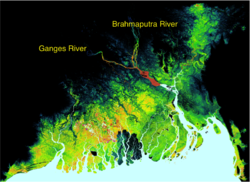Lab-0006: Difference between revisions
From CSDMS
No edit summary |
No edit summary |
||
| Line 22: | Line 22: | ||
}} | }} | ||
{{LabClassroomOrganization | {{LabClassroomOrganization | ||
|LabCOIntro=This lab | |LabCOIntro=This lab replicates and improves upon simulations originally run by Frances Dunn and Stephen Darby, reported in Darby et al. 2015. This simulation is driven by climate predictions (daily temperature and precipitation) obtained from the Hadley Centre (HadRM3P) Regional Climate Model. The Q0 realization is utilized in this lab. | ||
This lab will run HydroTrend simulation with Python Modeling Tool (Pymt). If you have never used the Pymt, learn how to use it: https://pymt.readthedocs.io/en/latest/install.html. The Pymt allows you to set up simulations and run notebooks. | This lab will run HydroTrend simulation with Python Modeling Tool (Pymt). If you have never used the Pymt, learn how to use it: https://pymt.readthedocs.io/en/latest/install.html. The Pymt allows you to set up simulations and run notebooks. | ||
| Line 48: | Line 48: | ||
}} | }} | ||
{{LabTopicalLearningObjectives | {{LabTopicalLearningObjectives | ||
|LabTopicalLearningObjective= | |LabTopicalLearningObjective=Explore mean annual water discharge trends through time | ||
}} | }} | ||
{{LabNotes | {{LabNotes | ||
| Line 55: | Line 55: | ||
>> Open a new browser window and open the Pymt read the docs page: https://pymt.readthedocs.io/en/latest/examples.html | >> Open a new browser window and open the Pymt read the docs page: https://pymt.readthedocs.io/en/latest/examples.html | ||
>> You will see that there are several example models. In this lab we will select the HydroTrend | >> You will see that there are several example models. In this lab we will select the HydroTrend Ganges. | ||
>> Click on the 'Launch Binder' box and it will allow you to see this lab as a Jupyter Notebook. | >> Click on the 'Launch Binder' box and it will allow you to see this lab as a Jupyter Notebook. | ||
>> You can execute the Jupyter notebook code cells using shift -enter. | >> You can execute the Jupyter notebook code cells using shift -enter. | ||
|LabNotesFigure= | |LabNotesFigure=Launch binder Ganges.png | ||
|LabNotesFigureCaption=Launch binder | |LabNotesFigureCaption=Launch binder | ||
|LabNotesRequirements=-- | |LabNotesRequirements=-- | ||
Revision as of 10:56, 16 April 2020
Future Sediment Flux of the Ganges River
Contributor(s)
Irina Overeem at INSTAAR - University of Colorado.
Introduction
The Ganges-Brahmaputra Delta is one of the largest deltas in the world. In Bangladesh alone, 160 million people live in the floodplains. The Ganges and Brahmaputra Rivers and their delta are strongly impacted by the Asian summer monsoon. Widespread hazards relate to the intense seasonal rainfall: flooding, river erosion and channel switches. The people of Bangladesh have adapted to this dynamic delta system, they have raised villages above the annual flood level and embanked agricultural land.
Classroom organization
This lab replicates and improves upon simulations originally run by Frances Dunn and Stephen Darby, reported in Darby et al. 2015. This simulation is driven by climate predictions (daily temperature and precipitation) obtained from the Hadley Centre (HadRM3P) Regional Climate Model. The Q0 realization is utilized in this lab.
This lab will run HydroTrend simulation with Python Modeling Tool (Pymt). If you have never used the Pymt, learn how to use it: https://pymt.readthedocs.io/en/latest/install.html. The Pymt allows you to set up simulations and run notebooks.
If you are a faculty at an academic institution, it is possible to work with us to get temporary teaching accounts. Work directly with us by emailing: csdms@colorado.eduLearning objectives
Skills
Skills
- use Pymt to run HydroTrend Model
- familiarize with a basic configuration of the HydroTrend Model
- make small changes to key input parameters
- hands-on experience with visualizing output in Python
Key concepts
- Simulation of the river discharge for Ganges River
- Simulation of the suspended sediment discharge for Ganges River
- Explore mean annual water discharge trends through time
Lab notes
You can launch binder to directly run the Jupyter Notebook for this lab through a web browser.
>> Open a new browser window and open the Pymt read the docs page: https://pymt.readthedocs.io/en/latest/examples.html
>> You will see that there are several example models. In this lab we will select the HydroTrend Ganges.
>> Click on the 'Launch Binder' box and it will allow you to see this lab as a Jupyter Notebook.
>> You can execute the Jupyter notebook code cells using shift -enter.Requirements
--
References
- Kettner, A.J., and Syvitski, J.P.M., 2008. HydroTrend version 3.0: a Climate-Driven Hydrological Transport Model that Simulates Discharge and Sediment Load leaving a River System. Computers & Geosciences, 34(10), 1170-1183. doi: 10.1016/j.cageo.2008.02.008


